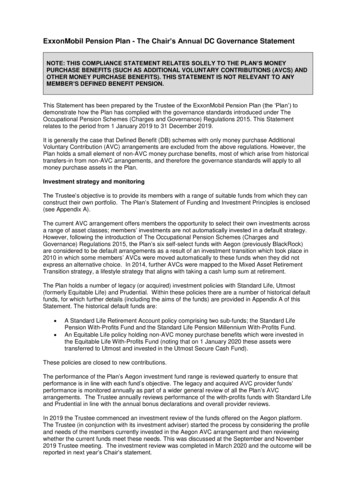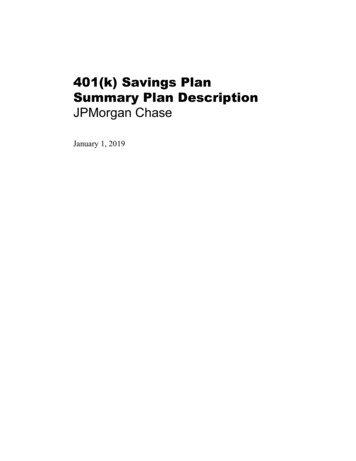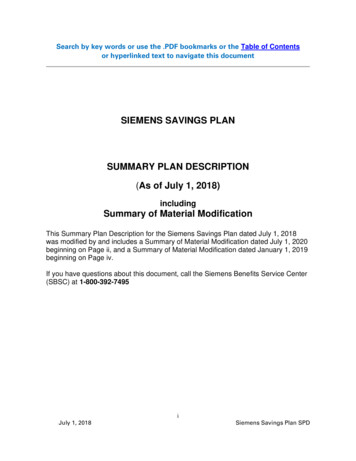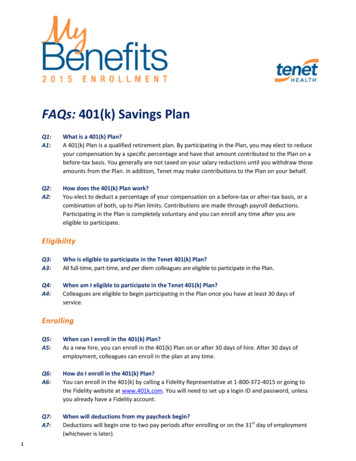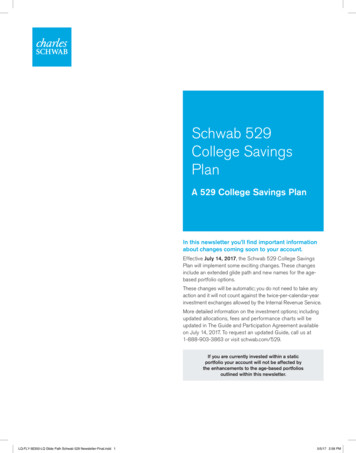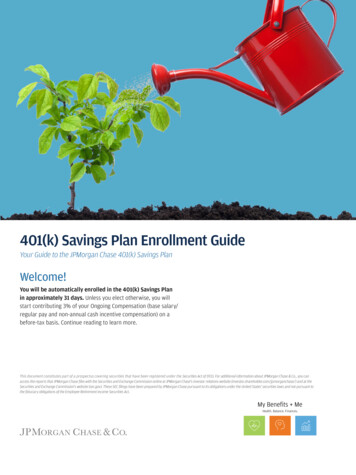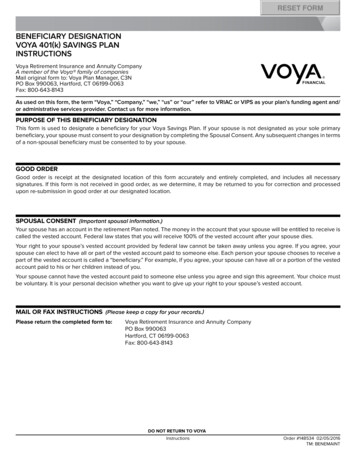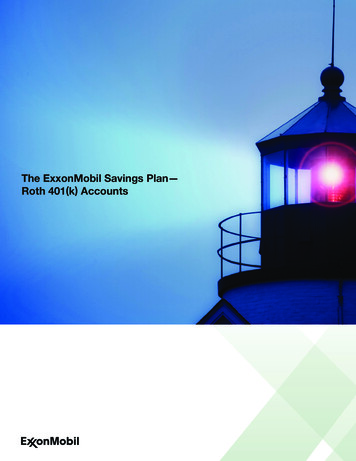
Transcription
The ExxonMobil Savings Plan—Roth 401(k) Accounts
An opportunity to build tax-freeretirement income.Who might benefit from a Roth 401(k)?Do you think your tax rate will be higher by the time you retire and take distribution? Canyou afford to make after-tax contributions? Are you fine with not having in-service accessto funds? Do you plan to leave your money in the Savings Plan for at least five years andtake distribution after age 59½? If so, Roth 401(k) contributions may make sense for you.Read on to learn more.Roth Account OptionsNew accounts have been added the ExxonMobil Savings Plan. You now have three newways to participate in the Savings Plan for the opportunity to have tax-free income in yourretirement years. Roth 401(k) Account – contains employee Roth 401(k) contributions,including Roth catch-up contributions Roth Rollover Account – contains rollover contributions from other eligible Roth401(k) plans (e.g., from former employers) Roth Conversion Account – contains assets you elect to convert fromexisting Savings Plan accountsThese new Roth accounts have been added to the following existing ExxonMobil SavingsPlan accounts: Before-Tax Account – contains employee before-tax contributions, includingcatch-up contributions After-Tax Account – contains post-1986 employee after-tax contributions General Account – contains the company match and rollover contributions fromother eligible plans Stock Match Account – contains the pre-2007 company match provided in theform of ExxonMobil stock.This brochure will help you learn more about the new Roth accounts.2
A qualified distribution is awithdrawal or distribution madeHow do the new Roth accounts differfrom the existing Savings Plan accounts? Roth 401(k) Contributions vs. Before-Tax ContributionsBefore-tax contributions are made from before-tax funds; taxes are deferred oncontributions and earnings until you make a withdrawal. Roth 401(k) contributionsare made from after-tax funds. However, earnings on Roth contributions aretax-free if you hold funds in the Roth 401(k) Account for at least five years and donot withdraw them until you are at least 59½ years old. In other words, qualifieddistributions from the Roth 401(k) Account are not subject to any additional taxes.If you expect to be in a higher tax bracket in retirement than you are today, youmay benefit from paying taxes on Roth contributions today and building tax-freeincome for retirement. Conversely, if you expect to be in a lower tax bracket inretirement, you may prefer to make before-tax contributions today and deferpaying taxes until you withdraw the money in retirement.Be sure to carefully consider the impact on your take home paybefore you elect to make Roth 401(k) contributions, which will resultin a larger amount being taxed and withheld from yourpaycheck compared to before-tax contributions.after a 5-year period of Rothparticipation and made after youturn 59½ years old (or upondeath or disability). Your 5-yearperiod of Roth participationgenerally begins on January 1of the year in which you firstmake a Roth contribution intothe Savings Plan and ends at theend of the fifth consecutive year.How much can you contributeto a Roth 401(k) Account?In 2011, your Roth 401(k) andbefore-tax contributions have acombined limit of 16,500 (or 22,000, if you are 50 or older).For example, if you contribute 10,000 to your Before-TaxAccount, you can also contributeup to 6,500 to your Roth401(k) Account. If you are 50 orolder, you can make additionalcatch-up contributions of upto 5,500 (before-tax catch-upcontributions, Roth catch-upcontributions, or a combinationof both) for a combined total of 22,000. See page 5 for 2012contribution limits.3
What are the key advantagesof each contribution type?Before-tax Reduces current incometax, resulting in higher takehome pay; defers tax oncontributions and earningsuntil distribution If you expect to be in a lowertax bracket in retirement,deferring tax until distributionin retirement may be beneficialAfter-tax Defers tax on earnings untildistribution. If you expect tobe in a lower tax bracket inretirement, deferring tax untildistribution in retirement maybe beneficial. Allows two withdrawalsper year for access to funds(taxes apply) Provides opportunity foradditional retirement savingsby allowing contributionsbeyond the IRS before-taxand Roth 401(k) contributionslimit, up to the lesser of 49,000 or 27% of youreligible pay in 2011. See page 5for 2012 contribution limits.Roth 401(k) Reduces future income tax;earnings are tax-free forqualified distributions If you expect to be in a highertax bracket in retirement,paying tax on contributionsnow to build tax-free incomelater may be beneficial4 Roth 401(k) Contributions vs. After-Tax ContributionsIn both the After-Tax Account and the Roth 401(k) Account, contributions aremade on an after-tax basis. However, in the After-Tax Account, taxes on earningsare paid upon withdrawal. In a Roth 401(k) Account, withdrawal of earnings istax-free if the withdrawal is a qualified distribution.Another key difference is in the access to funds. The Savings Plan allowsyou to take two in-service withdrawals per calendar year from your After-TaxAccount. However, as an active employee, you can only access your Roth 401(k)contributions in cases of pre-defined hardship.Be sure to consider accessibility of funds when determining whether andhow much to contribute to the Roth 401(k) Account.Additional Roth 401(k) FeaturesThe Roth accounts have the same basic features as the other accounts in theSavings Plan. For example, the investment options are the same. The Companyprovides an employer match on minimum employee contributions. And you canstill take loans against account balances and receive dividends on investments.
Comparing contribution options: three paths to long-term investingYou can contribute to the Savings Plan using any combination of these options. Here’s alook at the benefits and restrictions of each contribution type.Comparison of employee contributions in current ExxonMobil Savings PlanAccounts and new Roth 401(k) AccountCurrent ExxonMobil Savings PlanContribution TypeAfter-TaxBefore-TaxRoth 401(k)Tax Treatment ofContributionTaxes paid upfrontTaxed upondistributionTaxes paid upfrontTax Treatment ofEarningsTaxed upondistributionTaxed upondistributionNot taxed ifqualified distributionNot applicable 16,500; 22,000 for participants age 50 and olderContribution Limits (2011)be effective at the beginningof the next full payrollNot applicableperiod after your request is 17,000; 22,500 for participants age 50 and olderAll contributions (including employer match) cannot exceed 50,000 or 27% of salaryEmployer Match onMinimum contributionYesLoans PermittedYesDistributionscontribution elections willAll contributions (including employer match) cannot exceed 49,000 or 27% of salaryContribution Limits (2012)In-Service Withdrawals(Taxable amount maybe subject to 10%penalty tax)Reminder: Changes toLimit 2 per yearHardship onlyprocessedHardship onlyRequired distributions starting at age 70½Need help with your decision?Use the Roth Contribution Estimator on the Savings Plan Web site.It lets you compare how various contributions could affect your take home pay today –and your retirement savings in the future. Access this tool anytime on the Savings Plan Website at https://xomsavings.ingplans.com. Follow the instructions to review your options anddetermine the best combination of contributions to meet your retirement income goals.5
Examples: Roth vs. Before-Tax ContributionsThe two types of contributions can impact paychecks and long-term returns indifferent ways. In these two examples, one employee benefits from Roth 401(k)contributions, while the other is better off staying with before-tax contributions.William, age 50 Contributes either 10,000 before-tax to the Before-Tax Account, or alternatively,contributes the equivalent after-tax amount to the Roth 401(k) Account. Has a 15% tax rate today and expects to be in a 25% tax bracket at distribution Will take a distribution from his account in 10 years when he retiresRoth 401(k)Before-Tax 401(k)Contributions for the year 8,500* 10,000Account value after 10 years(assuming 8% growth) 18,350 21,589Federal tax on distribution (at 25%)0( 5,397)Total after-tax value of the one yearcontribution at distribution 18,350 16,192* 8,500 is the equivalent of 10,000 on an after-tax basis after 15% tax rate is applied.This example is for illustrative purposes only. Returns may be more or less depending on actual performance.William’s Roth 401(k) will produce a greater after-tax value at distribution because his taxrate in retirement (25%) is higher than his current tax rate (15%).6
Jennifer, age 45 Contributes either 10,000 before-tax to the Before-Tax Account, or alternatively,contributes the equivalent after-tax amount to the Roth 401(k) Account. Has a 33% tax rate today and expects to be in a 28% tax bracket at distribution Will take distribution from her account in 15 years when she retiresRoth 401(k)Before-Tax 401(k)Contributions for the year 6,700* 10,000Account value after 15 years (assuming8% growth) 21,254 31,722Federal tax on distribution (at 28%)0( 8,882)Total after-tax value of the one yearcontribution at distribution 21,254 22,840* 6,700 is the equivalent of 10,000 on an after-tax basis after 33% tax rate is applied.This example is for illustrative purposes only. Returns may be more or less depending on actual performance.If Jennifer’s goal is to accumulate as much money as she can at distribution, she’sbetter off making before-tax 401(k) contributions. That’s because she expects to be in alower tax rate at distribution. In other words, she can save more over time by deferringtaxes now (at a 33% tax rate) and paying taxes later (at a 28% tax rate).7
If you have less thanfive years of participationin the Savings Plan, thereare restrictions on theamount you can convert.Please refer to the SavingsPlan Web site athttps://xomsavings.ingplans.com.In-plan Roth ConversionOnce a year, you may also convert money in existing accounts inwhich you are fully vested into the new Roth Conversion Account.You must request the conversion by December 15 of the year in whichyou want to convert. There is no minimum or maximum limit on theamount that can be converted. Employees younger than 59½ can convert funds in their After-Tax,General, and Stock Match Accounts to the Roth Conversion Account.However, funds in the Before-Tax Account cannot be converted. Employees 59½ or older can convert a portion or all of theirSavings Plan balance to the Roth Conversion Account. Retirees and terminees can convert a portion or all of theirSavings Plan balance to the Roth Conversion Account.Important: If you convertExxonMobil stock held in yourexisting Savings Plan accountsThe in-plan Roth conversion will not count against the two withdrawalsallowed per year from the After-Tax Account.Important considerations for in-plan conversionsAccount, you will permanentlyYou will need to pay tax on the converted assets as if they were distributed.As always, any tax-paid balance you have could offset the taxable amount ofthe distribution.lose the opportunity to use the However, any ExxonMobil stock converted is taxed at the currentinto the Roth Conversionadvantageous tax treatmenton any unrealized gain on thestock at the time of conversionthrough the IRS provisions onNet Unrealized Appreciation(NUA). The EY Financial PlannerLine at 1-866-966-1337 isavailable to help.8stock price with no opportunity to use the favorable tax treatment onthe Net Unrealized Appreciation (NUA). Also, the 10% early withdrawal penalty does not apply at conversion.There is no tax withholding so you are responsible for estimating and payingthe amount of tax owed. You may not be able to access Savings Plan funds for the purpose ofpaying taxes owed or you may incur additional income taxes plus anearly withdrawal penalty on any Savings Plan funds you do access. You may need to make quarterly estimated payments and/or increasepayroll withholding to avoid penalties.An in-plan Roth conversion is irrevocable, and any tax owed on suchconversion is also irrevocable.
The decision to make an in-plan Roth conversion is extremely complex. It is stronglyrecommended that you consult your financial and tax advisors if you are thinking about makingan in-plan conversion.Think carefully before you decide to make a Roth conversion. The EY FinancialPlanner Line is available to help. Call 1-866-966-1337, Monday through Friday(except holidays) from 8:00 a.m. to 7:00 p.m. Central Time.Need help making your decision? Here’s how to learn more.Webinars: Look for information about Roth 401(k) webinars. These are great opportunities to learnabout the pros and cons of your new Roth options. This service is for active employees only.EY Financial Planner Line: Call 1-866-966-1337, Monday through Friday (except holidays)from 8:00 a.m. to 7:00 p.m. Central Time. Note that these planners will not provide tax advice orrecommend specific investments. This service is for active employees only.Ernst & Young Financial Planning Center Web site: Go to http://exxonmobil.eyfpc.com,Company code XOM, Company program FFP, for financial education tools and resources to helpyou secure a better financial future. This service is for active employees only.Savings Plan Web site: Learn more about Roth at https://xomsavings.ingplans.comIRS Web site: www.irs.govYour tax advisor: Tax considerations for making Roth contributions and/or conversions arecomplex. You should consult with an independent qualified tax advisor before making a decision.Your financial advisor: He or she can help you evaluate how the different contribution typesmay fit within your overall retirement investment strategy and the specific investments for eachcontribution type.9
FrequentlyAsked QuestionsWhat is a Roth 401(k)?A Roth 401(k) is a retirement savings account that combines the featuresof a 401(k) account (or Before-Tax Account in the Savings Plan) with thetax-free growth benefits of a Roth IRA. Contributions to a Roth 401(k) aremade on an after-tax basis. Earnings are tax-free if certain criteria are met.See page 3 for more information on requirements for a qualified distribution.Do I have to contribute to the Roth?No, Roth contributions are optional.Do I have to max out my Before-Tax Account before I can contributeto the Roth 401(k) account?No. Roth contributions can either replace or complement your before-taxcontributions. You can contribute up to 16,500 (or 22,000 if age 50 orolder) in 2011 on a before-tax, Roth 401(k), or combined basis.Can I make both Roth 401(k) contributions and after-taxcontributions?Yes. Total contributions of all types – before-tax, Roth 401(k), after-tax,and the employer match – cannot exceed the lesser of 49,000 or 27% ofeligible pay in 2011.How do Roth rollovers work?You can roll over money from other eligible Roth 401(k) Plans and direct itinto the Roth Rollover Account. Once the funds are rolled over, you cannotwithdraw the money until you terminate employment.Into what fund options can I invest my Roth contributions?Whether you make before-tax, after-tax, or Roth 401(k) contributions, yourinvestment options under the Savings Plan are the same. See the SavingsPlan Web site for a list of investment options.Does an in-plan conversion count as a withdrawal?Yes, an in-plan conversion is considered a withdrawal and is thereforetaxable. However, the conversion does not count against your two allowablewithdrawals per year from your After-Tax Account. Learn more about in-planconversions on page 8.What if I make an in-plan conversion and change my mind later?Roth conversions are irrevocable. You cannot transfer funds back to theoriginal accounts.10
Can I take out a withdrawal to pay the taxes on an in-planconversion?Yes, if you have withdrawal rights. This would be a separate transaction,but be sure to consult your tax advisor. Taxes are due when you file your taxreturn or submit estimated taxes, if applicable.Can I access funds in my Roth accounts?As an active employee, your access to funds in your Roth accountsdepends on which Roth account you want to use. For funds in the Roth401(k) Account, the Savings Plan does not permit in-service access, withthe exception of hardship withdrawals.For funds in the Roth Rollover Account, the Savings Plan does not permitin-service access.For funds converted to the Roth Conversion Account, you have the samewithdrawal rights that you had before the funds were converted.How is the taxable five-year period calculated?This period begins on the first day of the calendar year in which you makeyour first Roth 401(k) contribution or in-plan rollover, and ends after fiveconsecutive calendar years have passed. For example, if you make yourfirst contribution in December 2011, you would receive credit for the entire2011 calendar year, and your five-year period ends on December 31, 2015.If you make a Roth rollover contribution into the Savings Plan, your period ofRoth participation begins on January 1 of the year in which you first madea Roth contribution to the plan from which you rolled the Roth money, if thatdate is earlier.What if I have an emergency and need access to my money, can Imake a withdrawal from my Roth 401(k) Account?Roth 401(k) contributions, but not earnings, are available for hardshipdistributions. See the Savings Plan Web site for hardship definitions.Who should I call if I have questions?You can call the Savings Plan Telephone Service (STS) to speak with aCustomer Service Associate weekdays (excluding stock market holidays)from 7:00 a.m. to 6:00 p.m. Central Time. Call 877-XOM-401K(877-966-4015) and press “0”.Before you make anydecisions, make sure youunderstand how Rothaccounts work. If you cananswer “yes” to thesequestions, you’re off to agreat start. All the answersare in this brochure.Do you understand: The differences between theRoth 401(k), Before-Tax, andAfter-Tax Accounts? How much you can contributeto each account? How Roth 401(k) contributionswill affect your take home pay? The definition of a“qualified distribution” froma Roth account? All the rules and restrictionsaround converting your non-RothSavings Plan account funds tothe Roth Conversion Account?11
ExxonMobil Savings Planhttps://xomsavings.ingplans.comPweb XOMRoth 11/11
New accounts have been added the ExxonMobil Savings Plan. You now have three new ways to participate in the Savings Plan for the opportunity to have tax-free income in your retirement years. Roth 401(k) Account – contains employee Roth 40

